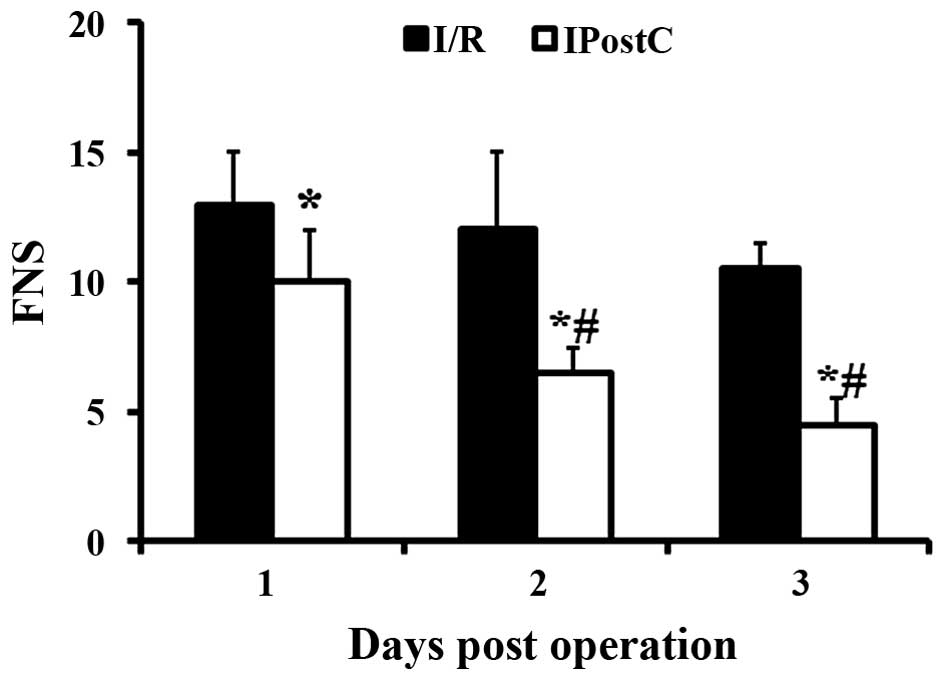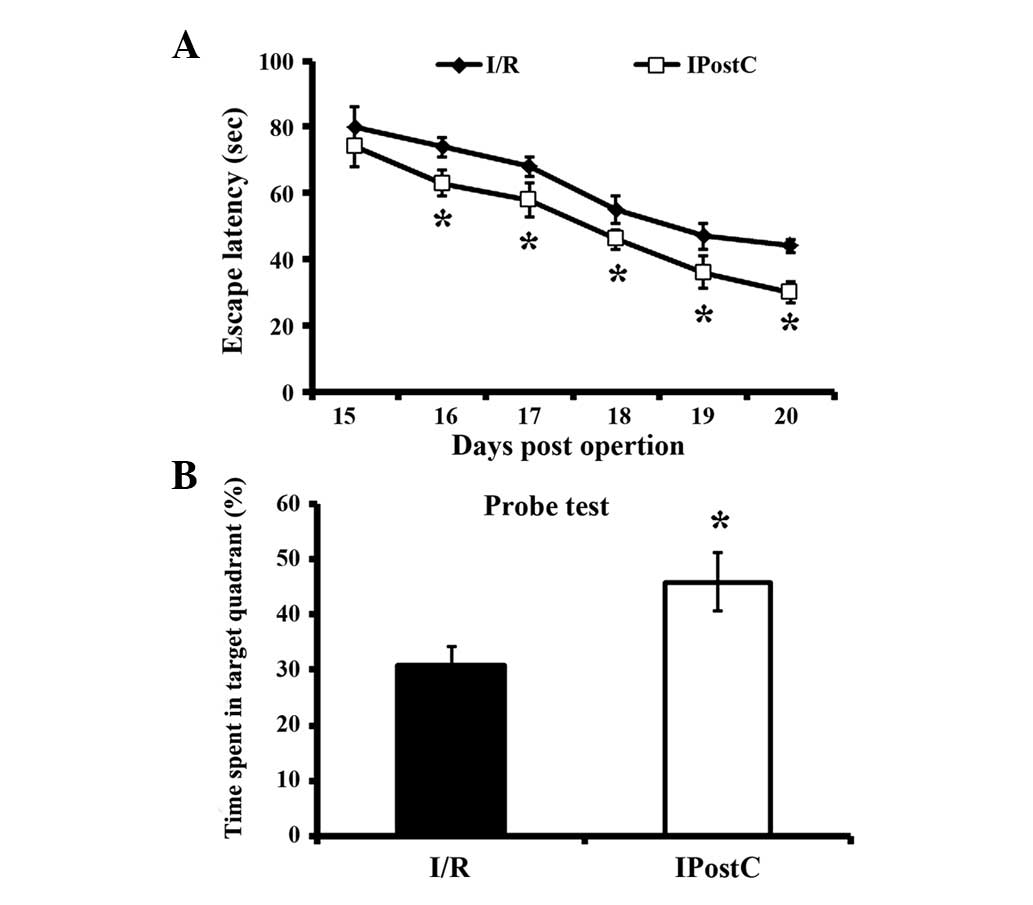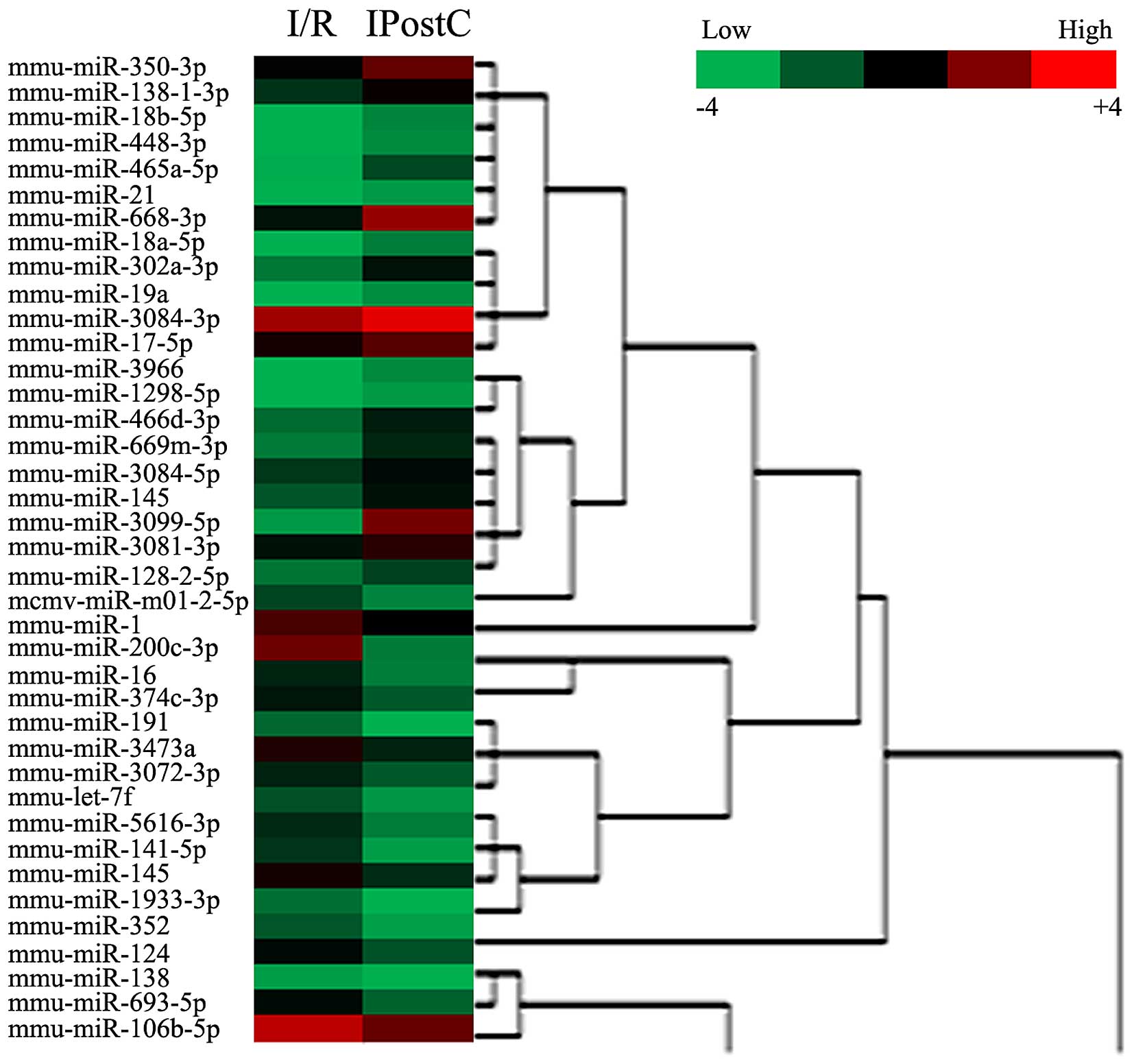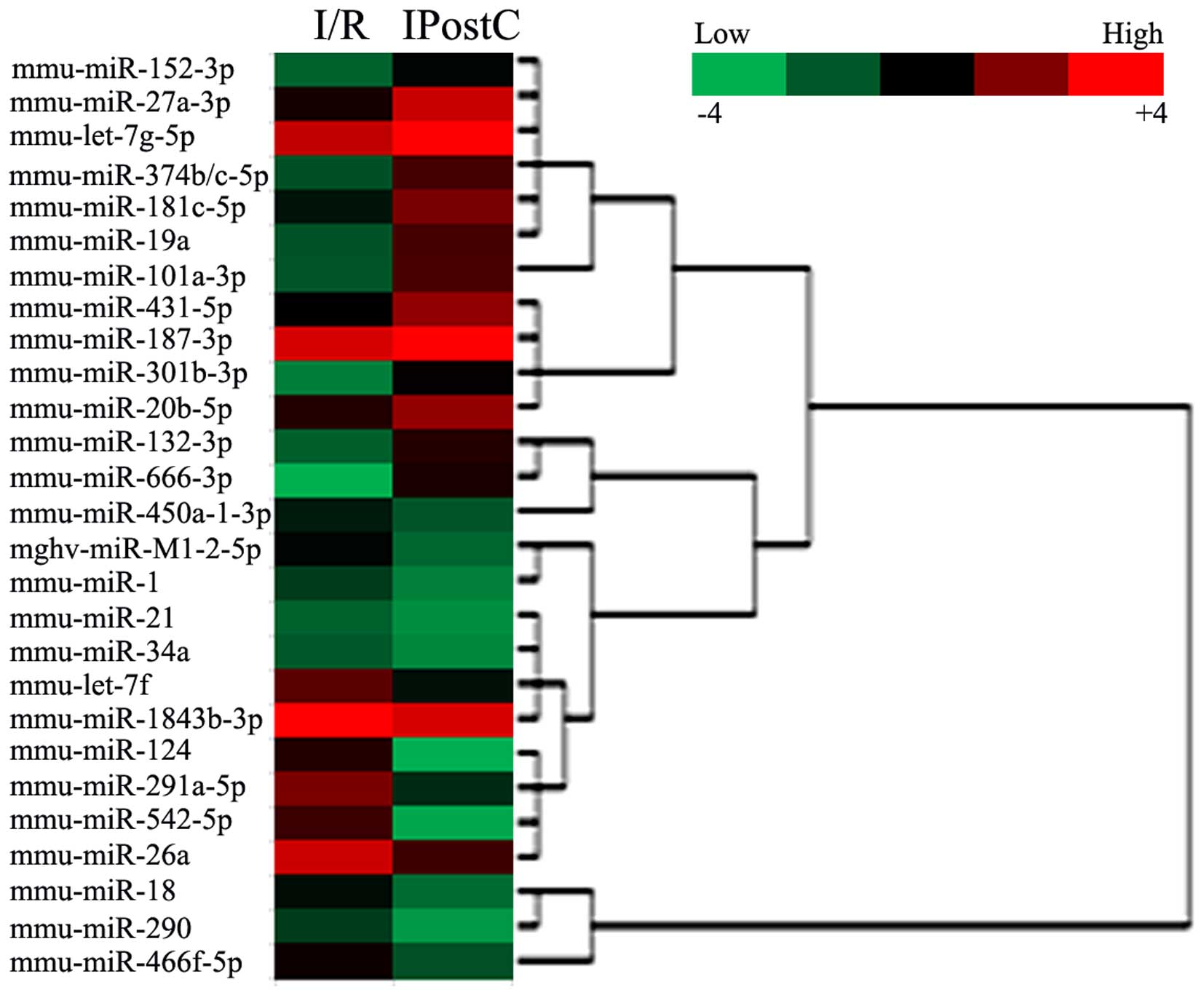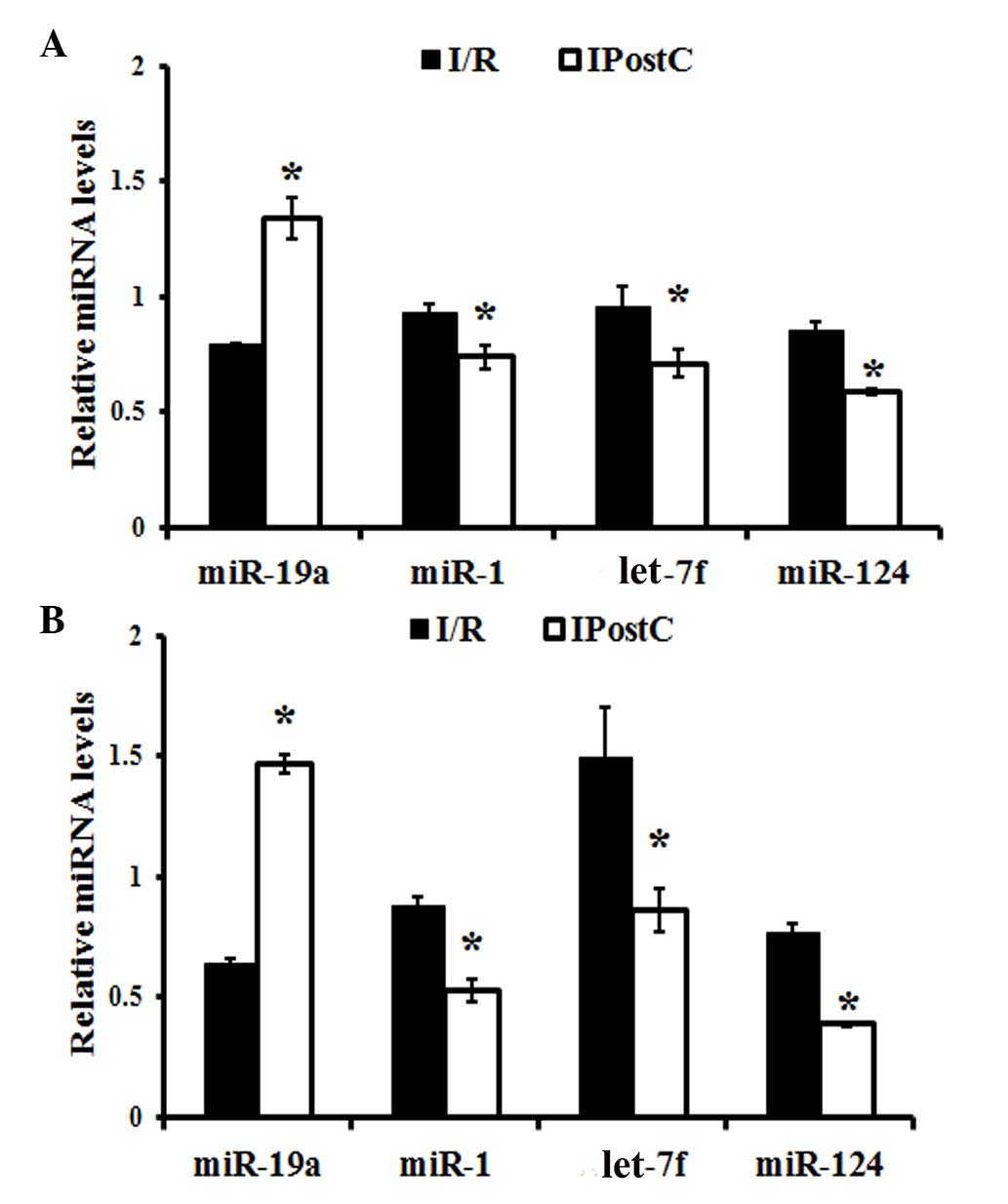Neuroprotection induced by post-conditioning following ischemia/reperfusion in mice is associated with altered microRNA expression
- Authors:
- Published online on: July 29, 2016 https://doi.org/10.3892/mmr.2016.5576
- Pages: 2582-2588
-
Copyright: © Miao et al. This is an open access article distributed under the terms of Creative Commons Attribution License.
Abstract
Introduction
Ischemic brain injury is the underlying pathophysiology of various common diseases, including traumatic injury and stroke, which is the second leading cause of mortality worldwide and a primary cause of disability (1). Rapid revascularization of the occluded vessels and early reperfusion are recommended to limit cerebral ischemic damage. However, ischemia-reperfusion (I/R) injury may occur (2), causing post-ischemic tissue damage (3). Efforts have been made to alter the patterns of reperfusion, thus alleviating I/R injury (3,4). However, to date, effective and safe methods to reduce ischemic brain injury remain to be established.
Ischemic postconditioning (IPostC), an emerging concept for stroke treatment, refers to a series of rapid intermittent blood flow interruptions early following reperfusion that alters the blood flow hydrodynamics (4,5). Previous studies have demonstrated that IPostC reduced infarct size, diminished necrosis and apoptosis, improved vascular endothelial dysfunction and restored neurological deficits following stroke, in numerous human organs and various animal models (5–7). IPostC compares well with ischemic preconditioning (4) and has demonstrated comparable protective effects (5,8). Previous studies have partially revealed the protective mechanisms underlying IPostC, which include: i) Attenuation of free radical generation (2,5); ii) inhibition of neutrophil infiltration and attenuation of proinflammatory cytokine and adhesion molecule expression in ischemic brain (5); and iii) promotion of neuronal survival molecular pathways (9) and inactivation of apoptotic cell signaling pathways (5,10). However, the majority of these studies were descriptive and lacked insight into the underlying molecular mechanisms of IPostC.
MicroRNAs (miRNAs), a novel class of noncoding RNAs, are important endogenous regulators that post-transcriptionally modulate the expression of target mRNAs via degradation or translational inhibition (11). miRNAs are critical for the maintenance of healthy cellular function. Quantifying miRNA expression levels and predicting their function as regulators of single targets and complex networks requires a combined approach of bioinformatics, molecular and systems biology. Previous studies have suggested the involvement of miRNAs in the regulation of I/R injury (12,13). However, alterations in miRNAs induced by cerebral IPostC in an I/R mouse model remain to be fully elucidated.
The present study examined alterations in miRNA expression levels in the cerebral cortex and hippocampus in an I/R mouse model following IPostC treatment using microarray analyses. Mice were subjected to I/R in the presence or absence of IPostC. Subsequently, their neurological functional impairment, and spatial learning and memory retention abilities were assessed. The cerebral cortex and hippocampus were then collected and miRNA analysis was performed. The results of miRNA array were confirmed using reverse transcription-quantitative polymerase chain reaction (RT-qPCR).
Materials and methods
Animal grouping and experimental design
Animals were randomly divided into two groups: i) I/R group (n=16), in which animals underwent 45 min ischemia followed by 72 h reperfusion; ii) IPostC group (n=17), in which I/R was followed by three cycles of 15 sec occlusion/30 sec release started at 2 min subsequent to reperfusion (IP15/30) (14).
Focal cerebral ischemia and IPostC
All investigations conformed to the Guide for the Care and Use of Laboratory Animals published by the National Institutes of Health (NIH Publication No. 85-23, revised 1996; Bethesda, MD, USA). The study was approved by the ethics committee of the Second Affiliated Hospital of Kunming Medical University (Kunming, China; permit no. ku-sah-2015004). A total of 36 male C57BL/6J mice (age, 4–4.5 months; weight, 22–25 g) were purchased from Kunming Medical University (Kunming, China). Animals were maintained on a standard diet and water accessed ad libitum, and housed at 20–25°C under a 12-h light/dark cycle. Efforts were made to minimize animal numbers and suffering.
Anesthesia was induced by 5% isoflurane (Sigma-Aldrich China, Inc., Shanghai, China) and maintained with 1–2% isoflurane during surgery. Focal ischemia was generated as described previously (9,14). Body core temperature was monitored with a rectal probe and maintained at 37±0.5°C using a heat mat. Briefly, under the operating microscope, the left common carotid artery (CCA) and external carotid artery (ECA) were exposed via a ventral midline neck incision, and were ligated proximally. A 6-0 silicon-coated nylon suture with a 0.23 mm tip diameter (Doccol Corporation, Sharon, MA, USA) was inserted through the arteriotomy in the CCA just below the carotid bifurcation 8±0.5 mm until a mild resistance was felt. The inserted suture was held in place with a 5-0 black silk suture (Beijing Cinontech Co., Ltd., Beijing, China) at the proximal CCA bifurcation. The suture was removed 45 min later to allow reperfusion in the ischemic control group. In the IPostC group, the suture was removed 2–3 mm and reinserted repeatedly as described previously (14). Following surgery, animals were returned to their cages. Three mice died following surgery (two in the I/R group and one in the IPostC group). Therefore, subsequent analyses were performed on 16 mice in the I/R group and 17 mice in the IPostC group.
Neurological score evaluation
Neurological scores were assessed at 1, 2 and 3 days post-operation (dpo). A 28 point scale of focal neurological scores (FNS) was employed as described previously (15), which comprised the following seven tests, all of which were scored from 0 to 4: i) Body symmetry, ii) gait, iii) climbing, iv) circling behavior, v) frontal limb symmetry, vi) compulsory circling, and vii) whisker response. Scores for each category were added up, giving a total score for each animal of 0–28.
Behavioral evaluations
A total of 14 days following surgery, the learning and memory impairment of mice were assessed. A Morris water maze (MWM) was used to examine spatial learning by training mice to locate an underwater platform using visual information, as described previously (16). The test was conducted three times per day each day from 15 to 20 dpo. The time required to find the hidden platform (escape latency; time limit, 90 sec) was recorded by an observer blinded to the treatment group and tracked using TopScan software version 3.1 (Clever Sys Inc., Reston, VA, USA). A 90 sec probe trial was performed 1 day subsequent to the final learning trial to assess memory. The platform was removed and the percentage of time spent in the quadrant where it was previously located was recorded.
miRNA microarray analysis
The miRCURY LNA™ Array (7th generation; version 18.0; Exiqon A/S, Vedbaek, Denmark) contains 3,100 capture probes, covering all human, mouse and rat miRNAs annotated in miRBase version 18.0 (www.mirbase.org/), and all viral miRNAs associated with these species.
Mice (n=3) were randomly selected from each group 20 days following surgery, subsequent to the MWM test, sacrificed by cervical dislocation and decapitated. Ischemic ipsilateral cortex and hippocampus were removed within 60 sec and frozen in −70°C isopentane until further analysis. Following careful rinsing in chilled phosphate-buffered saline, tissues from the three mice in each group were pooled and homogenized on ice using TRIzol® (Invitrogen; Thermo Fisher Scientific, Inc., Waltham, MA, USA), and total RNA was extracted using TRIzol® and a miRNeasy Mini kit (Qiagen, Inc., Valencia, CA, USA) according to manufacturer's instructions. RNA quality and quantity were examined using a Nanodrop spectrophotometer (ND-1000; NanoDrop Technologies; Thermo Fisher Scientific, Inc.) and RNA integrity was assessed by gel electrophoresis.
Following RNA isolation from the samples, the miRCURY Hy3/Hy5™ Power Labeling kit (Exiqon A/S) was used according to the manufacturer's instructions. The Hy3™-labeled samples were hybridized on the miRCURY LNA™ Array according to the manufacturer's instructions. The slides were then washed repeatedly with the Wash Buffer kit (Exiqon A/S) and centrifuged for 5 min at 80 × g, 20°C). Slides were scanned with the Axon GenePix® 4000B microarray scanner (Molecular Devices, LLC, Sunnyvale, CA, USA).
Scanned images were then imported into GenePix® Pro software version 6.0 (Molecular Devices, LLC) for grid alignment and data extraction. Replicated miRNAs were averaged and miRNAs with intensities ≥30 in all samples were chosen for normalization. Expressed data were normalized using the Median normalization (17). Subsequent to normalization, differentially expressed (DE) miRNAs were identified through Fold Change filtering [only normalized intensity ratios >2.0 or <0.5 (fold-changes ≥2.0) were defined as significantly altered miRNAs]. Hierarchical clustering was performed using MultiExperiment Viewer software, version 4.0 (www.tm4.org/mev.html) for classification analysis.
Expressional analysis of miRNA
RT-qPCR was performed to measure miRNA expression levels. The remaining mice (13 in the I/R and 14 in the IPostC groups) were sacrificed for miRNA analysis immediately following MWM assessment. Complementary DNA (cDNA) was synthesized from total RNA, and qPCR performed using gene-specific primers and the TaqMan® MicroRNA assay kit (Applied Biosystems; Thermo Fisher Scientific, Inc.), according to the manufacturer's instructions. The 10 µl PCR reaction contained 0.67 µl cDNA, 4 µl 1X TaqMan Universal PCR master mix and 1 µl primer and probe mix. qPCR was performed using an Applied Biosystems 7300 Sequence Detection system (Applied Biosystems; Thermo Fisher Scientific, Inc.). Samples were normalized to snoRNA202 (18). The threshold cycle was defined as the fractional cycle number at which the fluorescence exceeded the fixed threshold (19). The relative expression of genes was determined using the ΔΔCq method (20).
Statistical analysis
Data are expressed as the mean ± standard error. All statistical analyses were performed in SPSS version 14.0 (SPSS, Inc., Chicago, IL, USA). FNS were analyzed using the Kruskal-Wallis test followed by the Mann-Whitney U-test with Bonferroni correction. Post-hoc independent samples t-tests were used to assess significant differences between groups. P<0.05 was considered to indicate a statistically significant difference.
Results
Behavioral evaluation
Increased FNS indicated greater impairment (15). IPostC significantly decreased neurological scores at 1 (P=0.01), 2 (P=0.0024) and 3 (P<0.001) dpo compared with the I/R only group (Fig. 1). In addition, in the IPostC group but not in the I/R only group, FNS was significantly decreased at 2 and 3 dpo compared with 1 dpo.
Spatial orientation alteration
All mice subjected to I/R injury demonstrated significantly decreased escape latency from 16 dpo (Fig. 2). However, in the IPostC group, mice discovered the platform more rapidly than I/R alone mice, from 16 dpo to 20 dpo. In the probe test, IPostC mice spent a significantly increased percentage of time in the target quadrant on 21 dpo compared with I/R group mice, indicating that IPostC attenuated I/R-induced memory impairment.
IPostC resulted in DE miRNAs in cerebral cortex and hippocampus of I/R mice
To identify DE miRNAs induced by IPostC, a Fold Change filtering was performed. The miRNA expression profile heat map of these groups was generated by hierarchical clustering. The color gradient of the heat map represents the log of relative to mean miRNA expression, with red indicating overexpression and green underexpression. Hierarchical cluster analysis of these miRNAs identified DE miRNAs in cerebral cortex (Fig. 3) and hippocampus (Fig. 4) induced by IPostC.
In the cerebral cortex, 39 miRNAs were DE in I/R and IPostC mice, of which 21 were upregulated, and 18 were downregulated (Table I and Fig. 3). In addition, as presented in Table II and Fig. 4, IPostC induced DE miRNAs in the hippocampus. A total of 27 miRNAs were DE in I/R and IPostC groups, of which 13 were upregulated, and 14 were downregulated. The four miRNAs (miR-1, let-7f, miR-19a and miR-124) that were DE in cerebral cortex and hippocampus were selected for further analysis.
Quantitative analysis of miRNAs
The expression levels of miR-1, let-7f, miR-19a and miR-124 were evaluated using RT-qPCR. In the cerebral cortex, miR-19a expression levels were significantly increased (P<0.001), while miR-1 (P= 0.007), let-7f (P=0.002) and miR-124 (P=0.003) expression levels were significantly decreased, in the IPostC compared with the I/R group (Fig. 5A). Similar observations were made in the hippocampus of IPostC-treated mice, which demonstrated an upregulation of miR-19a expression levels (P<0.001) and downregulation of miR-1 (P=0.002), let-7f (P=0.001) and miR-124 (P=0.001) expression levels, compared with the I/R group (Fig. 5B).
Discussion
The present study revealed that IPostC, consisting of three cycles of 15 sec occlusion/30 sec release started 2 min following reperfusion, attenuated neurological impairment and hippocampus-associated cognitive deficits induced by I/R injury. In addition, it was demonstrated that IPostC induced alterations in miRNAs expression levels in the cerebral cortex and hippocampus following I/R. In particular, miR-1, let-7f, miR-19a and miR-124 expression levels were significantly altered by IPostC. These results indicate that modulation of miRNA expression by IPostC may contribute to the cognitive improvement of these mice following I/R injury.
FNS evaluation and MWM test results revealed that I/R produced significant and irreversible neurological deficits and long-term impairment in the cognitive abilities of mice, consistent with previous studies (14,21). However, in the present study, treatment with IPostC attenuated neurological deficits and cognitive performance in the MWM test induced by I/R. Previous studies have revealed that IPostC ameliorates neurological deficits and inhibited brain injury following stroke (22,23). It has been demonstrated that I/R destroys up to 85.8% of CA1 hippocampal neurons and 64.1% of parietal cortical neurons, which contribute to the cognitive impairment following injury (10). Evidence demonstrates the results of IPostC: i) Markedly reduced neuronal loss and delayed neuronal death following reperfusion; ii) significantly decreased neurological deficit scores, infarct volume and brain edema; and iii) diminished spatial learning and memory deficiency associated with cerebral ischemia (10,12,13). Although it is widely accepted that IPostC increases adult hippocampal neurogenesis and enhances behavioral performance in rodents, the mechanisms underlying this process remain to be fully elucidated. An epigenetic mechanism may be involved.
It has been demonstrated that miRNAs are crucial for the maintenance of healthy cellular function. They function primarily by binding to their target mRNAs, resulting in mRNA degradation or prevention of translation (24,25). Altered miRNA expression has various consequences for mRNA transcription and translation. Evidence indicates that miRNAs are involved in the regulation of I/R injury (26). A previous study demonstrated distinct expression patterns of miRNAs in stroke etiology, including atherosclerosis, hyperlipidemia, hypertension and plaque rupture (27). In addition, it has been revealed that focal ischemia significantly altered the temporal expression of numerous miRNAs, which may regulate the mRNA transcription and translation involved in stroke pathophysiology (28).
However, limited studies have investigated alterations in miRNA expression levels in the cerebral cortex and hippocampus of mice treated with IPostC following I/R injury (26). The present study revealed that there were numerous DE miRNAs in the cerebral cortex and hippocampus of I/R and IPostC-treated mice. Hierarchical cluster analysis of miRNA profiles suggested an epigenetic mechanism may contribute to the IPostC-associated improvement in the neurological and cognitive functions of mice suffering from I/R.
The results of the present study revealed that the expression levels of miR-1, let-7f and miR-124 were downregulated in IPostC-treated mice compared with I/R alone. A previous study has demonstrated the upregulated expression of specific miRNAs in rodent brains following I/R, suggesting miRNAs may be involved in the complex response to I/R (24). miRNA transcripts present in the blood and brain at 24 h following reperfusion included rno-miR-16, -23a, -191, -292-5p, -320, -451, -494 and let-7, while miRNAs observed in the blood and brain at 48 h included miR-26a, -26b, -103, -107, -150, -185, -195, -191, -214, -320, -328, -352, -494 and let-7 (29). Furthermore, the expression levels of miRNAs in blood have been revealed to be reproducible and diagnostic for lung cancer, colorectal cancer and diabetes (30). It has been demonstrated that following ischemia, anti-miR-1 treatment significantly reduced cortical infarct volume in adult female rats, while anti-let7 robustly reduced cortical and striatal infarcts, and preserved sensorimotor function and interhemispheric neural integration (31). Therefore, the neurological and cognitive improvement in I/R-injured mice resulting from IPostC treatment may involve miR-1 and let-7f regulation in the cerebral cortex and hippocampus. Brain-derived neurotrophic factor (BDNF) is a neurotrophin family secreted protein that regulates brain development, synaptogenesis and memory and learning (32). Evidence suggests that endogenous miR-1 and miR-10 act cooperatively as novel regulators of BDNF long and short 3′UTR isoforms (33). In the present study, IPostC reversed the upregulation of miR-1 following I/R, therefore the IPostC-induced cognitive improvement in I/R may involve miR-1/BDNF. However, further investigations are required to support this.
miR-124, the brain-specific miRNA involved in neural tube development, was upregulated in rats subjected to transient cerebral ischemia (34). The present study confirmed this finding, demonstrating increased miR-124 in brains from I/R, compared with IPostC, mice. This process may be associated with regeneration during the h of reperfusion in the injured brain cells. Therefore, the functional improvement induced by IPostC may be associated with expressional regulation of miR-124.
It was reported that miR-19b is critical for increasing the number of oligodendroglial cells (35). The overexpression of miR-19b downregulated phosphatase and tensin homolog protein levels and induced oligodendrocyte precursor cell proliferation via activation of downstream targets of the Akt signaling pathway [phosphoinositide 3-kinase (PI3K)/Akt/mammalian target of rapamycin (mTOR)] (35,36). In addition, Xie et al (22) revealed that IPostC provided long-term protection by enhancing Akt and mTOR activity during the acute post-stroke phase, which was abolished by mTOR inhibitor rapamycin administration. Therefore, the upregulation of miR-19b observed in the present study may activate the PI3 K/Akt/mTOR signaling pathway, accounting for the neuroprotection provided by IPostC following I/R.
In conclusion, the results of the present study demonstrate that IPostC following I/R resulted in an improvement in neurological and cognitive function, and alterations in miRNA expression levels in the cerebral cortex and hippocampus of mice of miR-1, let-7f, miR-19a and miR-124, alone or in combination with other miRNAs, were associated with this recovery process. Alterations in miR-1, let-7f, miR-19a and miR-124 expression in the cerebral cortex and hippocampus of mice following IPostC may be involved in this improvement. However, further experiments are required to confirm this involvement and determine the potential underlying mechanisms.
References
|
Durukan A and Tatlisumak T: Preconditioning-induced ischemic tolerance: A window into endogenous gearing for cerebroprotection. Exp Transl Stroke Med. 2:22010. View Article : Google Scholar : PubMed/NCBI | |
|
Zhao H, Sapolsky RM and Steinberg GK: Interrupting reperfusion as a stroke therapy: Ischemic postconditioning reduces infarct size after focal ischemia in rats. J Cereb Blood Flow Metab. 26:1114–1121. 2006.PubMed/NCBI | |
|
Lin XM, Zhang ZY, Wang LF and Zhang L, Liu Y, Liu XL, Yang XC, Cui L and Zhang L: Attenuation of tumor necrosis factor-alpha elevation and improved heart function by postconditioning for 60 sec in patients with acute myocardial infarction. Chin Med J (Engl). 123:1833–1839. 2010. | |
|
Zhao ZQ, Corvera JS, Halkos ME, Kerendi F, Wang NP, Guyton RA and Vinten-Johansen J: Inhibition of myocardial injury by ischemic postconditioning during reperfusion: Comparison with ischemic preconditioning. Am J Physiol Heart Circ Physiol. 285:H579–H588. 2003. View Article : Google Scholar : PubMed/NCBI | |
|
Zhao H: Ischemic postconditioning as a novel avenue to protect against brain injury after stroke. J Cereb Blood Flow Metab. 29:873–885. 2009. View Article : Google Scholar : PubMed/NCBI | |
|
Zhuo C, Wang Y, Wang X, Wang Y and Chen Y: Cardioprotection by ischemic postconditioning is abolished in depressed rats: Role of Akt and signal transducer and activator of transcription-3. Mol Cell Biochem. 346:39–47. 2011. View Article : Google Scholar | |
|
Ma XJ, Yin HJ, Guo CY, Jiang YR, Wang JS and Shi DZ: Ischemic postconditioning through percutaneous transluminal coronary angioplasty in pigs: Roles of PI3K activation. Coron Artery Dis. 23:245–250. 2012. View Article : Google Scholar : PubMed/NCBI | |
|
Zhao H: The protective effects of ischemic postconditioning against stroke: From rapid to delayed and remote postconditioning. Open Drug Discov J. 5:138–147. 2011.PubMed/NCBI | |
|
Xiong X, Gu L, Zhang H, Xu B, Zhu S and Zhao H: The protective effects of T cell deficiency against brain injury are ischemic model-dependent in rats. Neurochem Int. 62:265–270. 2013. View Article : Google Scholar : | |
|
Wang JY, Shen J, Gao Q, Ye ZG, Yang SY, Liang HW, Bruce IC, Luo BY and Xia Q: Ischemic postconditioning protects against global cerebral ischemia/reperfusion-induced injury in rats. Stroke. 39:983–990. 2008. View Article : Google Scholar : PubMed/NCBI | |
|
Ambros V: MicroRNA pathways in flies and worms: Growth, death, fat, stress, and timing. Cell. 113:673–676. 2003. View Article : Google Scholar : PubMed/NCBI | |
|
Wang X, Zhang X, Ren XP, Chen J, Liu H, Yang J, Medvedovic M, Hu Z and Fan GC: MicroRNA-494 targeting both proapoptotic and antiapoptotic proteins protects against ischemia/reperfusion-induced cardiac injury. Circulation. 122:1308–1318. 2010. View Article : Google Scholar : PubMed/NCBI | |
|
Peng B, Guo QL, He ZJ, Ye Z, Yuan YJ, Wang N and Zhou J: Remote ischemic postconditioning protects the brain from global cerebral ischemia/reperfusion injury by up-regulating endothelial nitric oxide synthase through the PI3K/Akt pathway. Brain Res. 1445:92–102. 2012. View Article : Google Scholar : PubMed/NCBI | |
|
Joo SP, Xie W, Xiong X, Xu B and Zhao H: Ischemic postconditioning protects against focal cerebral ischemia by inhibiting brain inflammation while attenuating peripheral lymphopenia in mice. Neuroscience. 243:149–157. 2013. View Article : Google Scholar : PubMed/NCBI | |
|
Hill JK, Gunion-Rinker L, Kulhanek D, Lessov N, Kim S, Clark WM, Dixon MP, Nishi R, Stenzel-Poore MP and Eckenstein FP: Temporal modulation of cytokine expression following focal cerebral ischemia in mice. Brain Res. 820:45–54. 1999. View Article : Google Scholar : PubMed/NCBI | |
|
Loane DJ, Pocivavsek A, Moussa CE, Thompson R, Matsuoka Y, Faden AI, Rebeck GW and Burns MP: Amyloid precursor protein secretases as therapeutic targets for traumatic brain injury. Nat Med. 15:377–379. 2009. View Article : Google Scholar : PubMed/NCBI | |
|
Min XL, Wang TY, Cao Y, Liu J, Li JT and Wang TH: MicroRNAs: A novel promising therapeutic target for cerebral ischemia/reperfusion injury? Neural Regen Res. 10:1799–1808. 2015. View Article : Google Scholar | |
|
Bhalala OG, Pan L, Sahni V, McGuire TL, Gruner K, Tourtellotte WG and Kessler JA: MicroRNA-21 regulates astrocytic response following spinal cord injury. J Neurosci. 32:17935–17947. 2012. View Article : Google Scholar : PubMed/NCBI | |
|
Ouchi Y, Banno Y, Shimizu Y, Ando S, Hasegawa H, Adachi K and Iwamoto T: Reduced adult hippocampal neurogenesis and working memory deficits in the Dgcr8-deficientmouse model of 22q11.2 deletion-associated schizophrenia can be rescued by IGF2. J Neurosci. 33:9408–9419. 2013. View Article : Google Scholar : PubMed/NCBI | |
|
Livak KJ and Schmittgen TD: Analysis of relative gene expression data using real-time quantitative PCR and the 2(-Delta Delta C(T)) method. Methods. 25:402–408. 2001. View Article : Google Scholar | |
|
Li H, Yin J, Li L, Deng J, Feng C and Zuo Z: Isoflurane postconditioning reduces ischemia-induced nuclear factor-κB activation and interleukin 1β production to provide neuroprotection in rats and mice. Neurobiol Dis. 54:216–224. 2013. View Article : Google Scholar : PubMed/NCBI | |
|
Xie R, Wang P, Ji X and Zhao H: Ischemic post-conditioning facilitates brain recovery after stroke by promoting Akt/mTOR activity in nude rats. J Neurochem. 127:723–732. 2013. View Article : Google Scholar : PubMed/NCBI | |
|
Rezazadeh H, Hoseini Kahnuee M, Roohbakhsh A, Shamsizadeh A, Rahmani MR, Bidaki R, Amin F, Kamali B, Bakhshi H and Allahtavakoli M: Neuroprotective consequences of postconditioning on embolic model of cerebral ischemia in rat. Iran J Basic Med Sci. 16:144–149. 2013.PubMed/NCBI | |
|
Zacharewicz E, Lamon S and Russell AP: MicroRNAs in skeletal muscle and their regulation with exercise, ageing, and disease. Front Physiol. 4:2662013. View Article : Google Scholar : PubMed/NCBI | |
|
Humphreys DT, Westman BJ, Martin DI and Preiss T: MicroRNAs control translation initiation by inhibiting eukaryotic initiation factor 4E/cap and poly(A) tail function. Proc Natl Acad Sci USA. 102:16961–16966. 2005. View Article : Google Scholar : PubMed/NCBI | |
|
Weiss JB, Eisenhardt SU, Stark GB, Bode C, Moser M and Grundmann S: MicroRNAs in ischemia-reperfusion injury. Am J Cardiovasc Dis. 2:237–247. 2012.PubMed/NCBI | |
|
Rink C and Khanna S: MicroRNA in ischemic stroke etiology and pathology. Physiol Genomics. 43:521–528. 2011. View Article : Google Scholar : | |
|
Dharap A, Bowen K, Place R, Li LC and Vemuganti R: Transient focal ischemia induces extensive temporal changes in rat cerebral MicroRNAome. J Cereb Blood Flow Metab. 29:675–687. 2009. View Article : Google Scholar : PubMed/NCBI | |
|
Jeyaseelan K, Lim KY and Armugam A: MicroRNA expression in the blood and brain of rats subjected to transient focal ischemia by middle cerebral artery occlusion. Stroke. 39:959–966. 2008. View Article : Google Scholar : PubMed/NCBI | |
|
Chen X, Ba Y, Ma L, Cai X, Yin Y, Wang K, Guo J, Zhang Y, Chen J, Guo X, et al: Characterization of microRNAs in serum: A novel class of biomarkers for diagnosis of cancer and other diseases. Cell Res. 18:997–1006. 2008. View Article : Google Scholar : PubMed/NCBI | |
|
Selvamani A, Sathyan P, Miranda RC and Sohrabji F: An antagomir to microRNA Let7f promotes neuroprotection in an ischemic stroke model. PLoS One. 7:e326622012. View Article : Google Scholar : PubMed/NCBI | |
|
Cacialli P, Gueguen MM, Coumailleau P, D'Angelo L, Kah O, Lucini C and Pellegrini E: BDNF expression in larval and adult Zebrafish brain: Distribution and cell identification. PLoS One. 11:e01580572016. View Article : Google Scholar : PubMed/NCBI | |
|
Varendi K, Kumar A, Härma MA and Andressoo JO: miR-1, miR-10b, miR-155, and miR-191 are novel regulators of BDNF. Cell Mol Life Sci. 71:4443–4456. 2014. View Article : Google Scholar : PubMed/NCBI | |
|
Cao X, Pfaff SL and Gage FH: A functional study of miR-124 in the developing neural tube. Genes Dev. 21:531–536. 2007. View Article : Google Scholar : PubMed/NCBI | |
|
Budde H, Schmitt S, Fitzner D, Opitz L, Salinas-Riester G and Simons M: Control of oligodendroglial cell number by the miR-17-92 cluster. Development. 137:2127–2132. 2010. View Article : Google Scholar : PubMed/NCBI | |
|
Olive V, Bennett MJ, Walker JC, Ma C, Jiang I, Cordon-Cardo C, Li QJ, Lowe SW, Hannon GJ and He L: miR-19 is a key oncogenic component of mir-17-92. Genes Dev. 23:2839–2849. 2009. View Article : Google Scholar : PubMed/NCBI |



